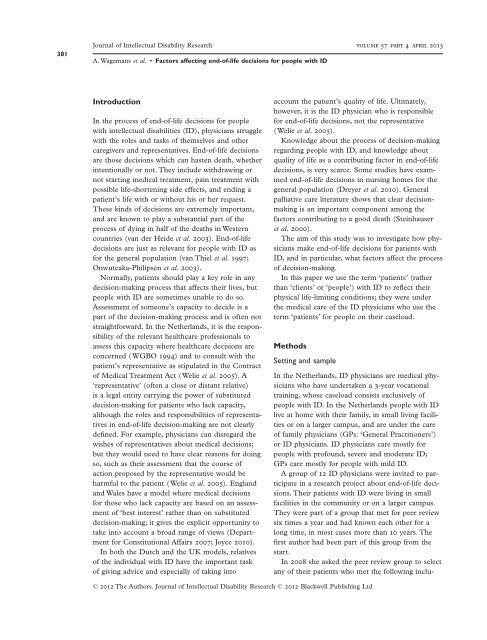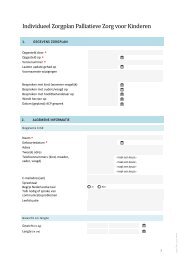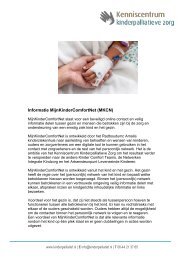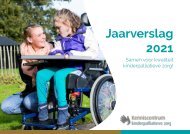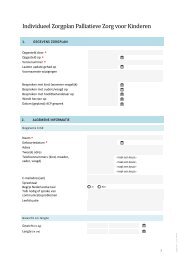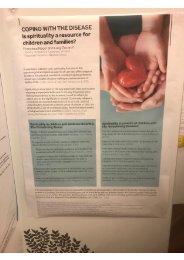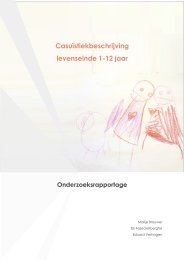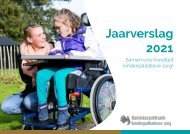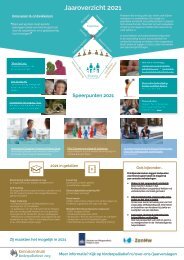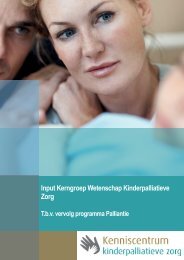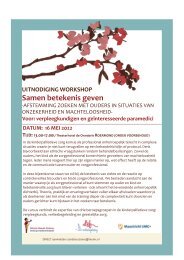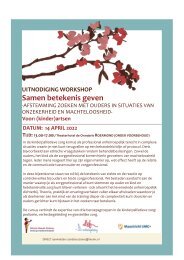The factors affecting end of life decision making by physicians of patients with intellectual disabilities in the Netherlands a qualitative study
You also want an ePaper? Increase the reach of your titles
YUMPU automatically turns print PDFs into web optimized ePapers that Google loves.
381<br />
Journal <strong>of</strong> Intellectual Disability Research volume 57 part 4 april 2013<br />
A. Wagemans et al. •Factors <strong>affect<strong>in</strong>g</strong> <strong>end</strong>-<strong>of</strong>-<strong>life</strong> <strong>decision</strong>s for people <strong>with</strong> ID<br />
Introduction<br />
In <strong>the</strong> process <strong>of</strong> <strong>end</strong>-<strong>of</strong>-<strong>life</strong> <strong>decision</strong>s for people<br />
<strong>with</strong> <strong><strong>in</strong>tellectual</strong> <strong>disabilities</strong> (ID), <strong>physicians</strong> struggle<br />
<strong>with</strong> <strong>the</strong> roles and tasks <strong>of</strong> <strong>the</strong>mselves and o<strong>the</strong>r<br />
caregivers and representatives. End-<strong>of</strong>-<strong>life</strong> <strong>decision</strong>s<br />
are those <strong>decision</strong>s which can hasten death, whe<strong>the</strong>r<br />
<strong>in</strong>tentionally or not. <strong>The</strong>y <strong>in</strong>clude <strong>with</strong>draw<strong>in</strong>g or<br />
not start<strong>in</strong>g medical treatment, pa<strong>in</strong> treatment <strong>with</strong><br />
possible <strong>life</strong>-shorten<strong>in</strong>g side effects, and <strong>end</strong><strong>in</strong>g a<br />
patient’s <strong>life</strong> <strong>with</strong> or <strong>with</strong>out his or her request.<br />
<strong>The</strong>se k<strong>in</strong>ds <strong>of</strong> <strong>decision</strong>s are extremely important,<br />
and are known to play a substantial part <strong>of</strong> <strong>the</strong><br />
process <strong>of</strong> dy<strong>in</strong>g <strong>in</strong> half <strong>of</strong> <strong>the</strong> deaths <strong>in</strong> Western<br />
countries (van der Heide et al. 2003). End-<strong>of</strong>-<strong>life</strong><br />
<strong>decision</strong>s are just as relevant for people <strong>with</strong> ID as<br />
for <strong>the</strong> general population (van Thiel et al. 1997;<br />
Onwuteaka-Philipsen et al. 2003).<br />
Normally, <strong>patients</strong> should play a key role <strong>in</strong> any<br />
<strong>decision</strong>-<strong>mak<strong>in</strong>g</strong> process that affects <strong>the</strong>ir lives, but<br />
people <strong>with</strong> ID are sometimes unable to do so.<br />
Assessment <strong>of</strong> someone’s capacity to decide is a<br />
part <strong>of</strong> <strong>the</strong> <strong>decision</strong>-<strong>mak<strong>in</strong>g</strong> process and is <strong>of</strong>ten not<br />
straightforward. In <strong>the</strong> Ne<strong>the</strong>rlands, it is <strong>the</strong> responsibility<br />
<strong>of</strong> <strong>the</strong> relevant healthcare pr<strong>of</strong>essionals to<br />
assess this capacity where healthcare <strong>decision</strong>s are<br />
concerned (WGBO 1994) and to consult <strong>with</strong> <strong>the</strong><br />
patient’s representative as stipulated <strong>in</strong> <strong>the</strong> Contract<br />
<strong>of</strong> Medical Treatment Act (Welie et al. 2005). A<br />
‘representative’ (<strong>of</strong>ten a close or distant relative)<br />
is a legal entity carry<strong>in</strong>g <strong>the</strong> power <strong>of</strong> substituted<br />
<strong>decision</strong>-<strong>mak<strong>in</strong>g</strong> for <strong>patients</strong> who lack capacity,<br />
although <strong>the</strong> roles and responsibilities <strong>of</strong> representatives<br />
<strong>in</strong> <strong>end</strong>-<strong>of</strong>-<strong>life</strong> <strong>decision</strong>-<strong>mak<strong>in</strong>g</strong> are not clearly<br />
def<strong>in</strong>ed. For example, <strong>physicians</strong> can disregard <strong>the</strong><br />
wishes <strong>of</strong> representatives about medical <strong>decision</strong>s;<br />
but <strong>the</strong>y would need to have clear reasons for do<strong>in</strong>g<br />
so, such as <strong>the</strong>ir assessment that <strong>the</strong> course <strong>of</strong><br />
action proposed <strong>by</strong> <strong>the</strong> representative would be<br />
harmful to <strong>the</strong> patient (Welie et al. 2005). England<br />
and Wales have a model where medical <strong>decision</strong>s<br />
for those who lack capacity are based on an assessment<br />
<strong>of</strong> ‘best <strong>in</strong>terest’ ra<strong>the</strong>r than on substituted<br />
<strong>decision</strong>-<strong>mak<strong>in</strong>g</strong>; it gives <strong>the</strong> explicit opportunity to<br />
take <strong>in</strong>to account a broad range <strong>of</strong> views (Department<br />
for Constitutional Affairs 2007; Joyce 2010).<br />
In both <strong>the</strong> Dutch and <strong>the</strong> UK models, relatives<br />
<strong>of</strong> <strong>the</strong> <strong>in</strong>dividual <strong>with</strong> ID have <strong>the</strong> important task<br />
<strong>of</strong> giv<strong>in</strong>g advice and especially <strong>of</strong> tak<strong>in</strong>g <strong>in</strong>to<br />
account <strong>the</strong> patient’s quality <strong>of</strong> <strong>life</strong>. Ultimately,<br />
however, it is <strong>the</strong> ID physician who is responsible<br />
for <strong>end</strong>-<strong>of</strong>-<strong>life</strong> <strong>decision</strong>s, not <strong>the</strong> representative<br />
(Welie et al. 2005).<br />
Knowledge about <strong>the</strong> process <strong>of</strong> <strong>decision</strong>-<strong>mak<strong>in</strong>g</strong><br />
regard<strong>in</strong>g people <strong>with</strong> ID, and knowledge about<br />
quality <strong>of</strong> <strong>life</strong> as a contribut<strong>in</strong>g factor <strong>in</strong> <strong>end</strong>-<strong>of</strong>-<strong>life</strong><br />
<strong>decision</strong>s, is very scarce. Some studies have exam<strong>in</strong>ed<br />
<strong>end</strong>-<strong>of</strong>-<strong>life</strong> <strong>decision</strong>s <strong>in</strong> nurs<strong>in</strong>g homes for <strong>the</strong><br />
general population (Dreyer et al. 2010). General<br />
palliative care literature shows that clear <strong>decision</strong><strong>mak<strong>in</strong>g</strong><br />
is an important component among <strong>the</strong><br />
<strong>factors</strong> contribut<strong>in</strong>g to a good death (Ste<strong>in</strong>hauser<br />
et al. 2000).<br />
<strong>The</strong> aim <strong>of</strong> this <strong>study</strong> was to <strong>in</strong>vestigate how <strong>physicians</strong><br />
make <strong>end</strong>-<strong>of</strong>-<strong>life</strong> <strong>decision</strong>s for <strong>patients</strong> <strong>with</strong><br />
ID, and <strong>in</strong> particular, what <strong>factors</strong> affect <strong>the</strong> process<br />
<strong>of</strong> <strong>decision</strong>-<strong>mak<strong>in</strong>g</strong>.<br />
In this paper we use <strong>the</strong> term ‘<strong>patients</strong>’ (ra<strong>the</strong>r<br />
than ‘clients’ or ‘people’) <strong>with</strong> ID to reflect <strong>the</strong>ir<br />
physical <strong>life</strong>-limit<strong>in</strong>g conditions; <strong>the</strong>y were under<br />
<strong>the</strong> medical care <strong>of</strong> <strong>the</strong> ID <strong>physicians</strong> who use <strong>the</strong><br />
term ‘<strong>patients</strong>’ for people on <strong>the</strong>ir caseload.<br />
Methods<br />
Sett<strong>in</strong>g and sample<br />
In <strong>the</strong> Ne<strong>the</strong>rlands, ID <strong>physicians</strong> are medical <strong>physicians</strong><br />
who have undertaken a 3-year vocational<br />
tra<strong>in</strong><strong>in</strong>g, whose caseload consists exclusively <strong>of</strong><br />
people <strong>with</strong> ID. In <strong>the</strong> Ne<strong>the</strong>rlands people <strong>with</strong> ID<br />
live at home <strong>with</strong> <strong>the</strong>ir family, <strong>in</strong> small liv<strong>in</strong>g facilities<br />
or on a larger campus, and are under <strong>the</strong> care<br />
<strong>of</strong> family <strong>physicians</strong> (GPs: ‘General Practitioners’)<br />
or ID <strong>physicians</strong>. ID <strong>physicians</strong> care mostly for<br />
people <strong>with</strong> pr<strong>of</strong>ound, severe and moderate ID;<br />
GPs care mostly for people <strong>with</strong> mild ID.<br />
A group <strong>of</strong> 12 ID <strong>physicians</strong> were <strong>in</strong>vited to participate<br />
<strong>in</strong> a research project about <strong>end</strong>-<strong>of</strong>-<strong>life</strong> <strong>decision</strong>s.<br />
<strong>The</strong>ir <strong>patients</strong> <strong>with</strong> ID were liv<strong>in</strong>g <strong>in</strong> small<br />
facilities <strong>in</strong> <strong>the</strong> community or on a larger campus.<br />
<strong>The</strong>y were part <strong>of</strong> a group that met for peer review<br />
six times a year and had known each o<strong>the</strong>r for a<br />
long time, <strong>in</strong> most cases more than 10 years. <strong>The</strong><br />
first author had been part <strong>of</strong> this group from <strong>the</strong><br />
start.<br />
In 2008 she asked <strong>the</strong> peer review group to select<br />
any <strong>of</strong> <strong>the</strong>ir <strong>patients</strong> who met <strong>the</strong> follow<strong>in</strong>g <strong>in</strong>clu-<br />
© 2012 <strong>The</strong> Authors. Journal <strong>of</strong> Intellectual Disability Research © 2012 Blackwell Publish<strong>in</strong>g Ltd


